BT12 Clinical Demonstration 10 - Assessing a Couple’s Developmental Stage & Selecting High-Impact Interventions - Ellyn Bader, PhD
- Average Rating:
- Not yet rated
- Topic Areas:
- Clinical Demonstrations | Developmental Psychology | Intervention Strategies
- Categories:
- Brief Therapy Conference | Brief Therapy Conference 2012 | Pioneers in Couples and Family Therapy
- Faculty:
- Ellyn Bader, PhD
- Duration:
- 1:02:45
- Format:
- Audio Only
- Original Program Date:
- Dec 07, 2012
- License:
- Never Expires.
Description
Description: Ellyn Bader demonstrates the "paper exercise," a powerful diagnostic technique for couples therapy. Partners negotiate a symbolic piece of paper, revealing critical relationship dynamics like communication patterns, conflict resolution, and emotional intimacy. The method provides therapists insights into a couple's developmental stage and potential intervention strategies.
Syllabus Description: Learn to quickly identify a couple’s developmental stage. Assess each partner’s role in maintaining arrested development and create an effective treatment plan that emphasizes “teamwork”.
Educational Objectives:
- Demonstrate how to use a couples history and presenting problem to identify their developmental stage.
- Select stage-specific interventions to target more rapid change.
*Sessions may be edited for content and to preserve confidentiality*
Credits
Handouts
| Timestamped Transcript (1.1 MB) | 27 Pages | Available after Purchase |
| Ericksonian Learning Snapshot (278.2 KB) | 3 Pages | Available after Purchase |
Faculty

Ellyn Bader, PhD Related Seminars and Products
Ellyn Bader, PhD, is a founder and director of The Couples Institute in Menlo Park, California. As a clinical psychologist, workshop leader, author, and speaker, she is dedicated to helping couples create extraordinary relationships. Over the past 30 years she has trained therapists in couples therapy throughout the United States as well as Europe, Asia, South America, and Australia. She served as a Clinical Faculty in Stanford University School of Medicine for 8 years.


